Stoplight Parrotfish, Sparisoma viride
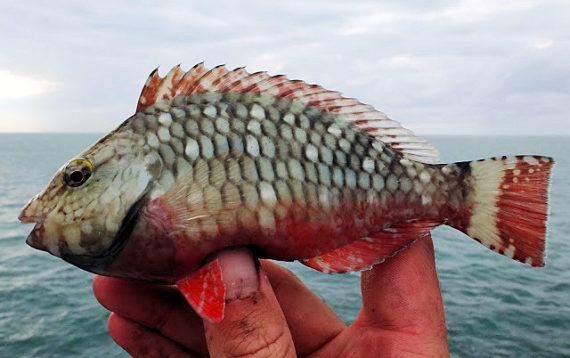 Stoplight Parrotfish, Sparisoma aurofrenatum, Initial Phase (IP) Female. Fish caught from coastal waters off Key Largo, Florida, December 2013. Length: 13 cm (5.0 inches). Catch, photograph and identification courtesy of Ben Cantrell, Peoria, Illinois.
Stoplight Parrotfish, Sparisoma aurofrenatum, Initial Phase (IP) Female. Fish caught from coastal waters off Key Largo, Florida, December 2013. Length: 13 cm (5.0 inches). Catch, photograph and identification courtesy of Ben Cantrell, Peoria, Illinois.
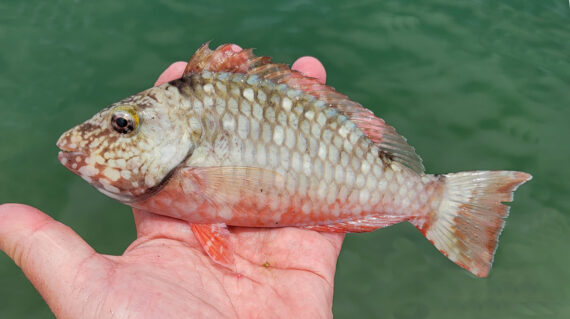 Stoplight Parrotfish, Sparisoma aurofrenatum, Initial Phase (IP) Female. Fish caught from coastal waters off Key Largo, Florida, December 2013. Length: 13 cm (5.0 inches). Catch, photograph and identification courtesy of Chris Moore, Peoria, Arizona
Stoplight Parrotfish, Sparisoma aurofrenatum, Initial Phase (IP) Female. Fish caught from coastal waters off Key Largo, Florida, December 2013. Length: 13 cm (5.0 inches). Catch, photograph and identification courtesy of Chris Moore, Peoria, Arizona
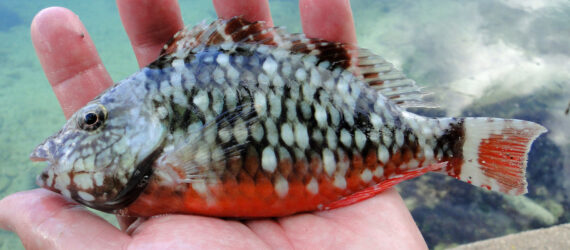 Stoplight Parrotfish, Sparisoma aurofrenatum, Initial Phase (IP) Female. Fish caught from coastal waters off Cancun, Quintano Roo, August 2013 Length: 13 cm (5.0 inches). Catch, photograph and identification courtesy of Dominick Porcelli, Lighthouse Point, Florida.
Stoplight Parrotfish, Sparisoma aurofrenatum, Initial Phase (IP) Female. Fish caught from coastal waters off Cancun, Quintano Roo, August 2013 Length: 13 cm (5.0 inches). Catch, photograph and identification courtesy of Dominick Porcelli, Lighthouse Point, Florida.
 Stoplight Parrotfish, Sparisoma aurofrenatum, Initial Phase (IP) Female. Fish caught from within the Hillsburo Inlet, Hillsburo Beach, Florida, July 2019. Length: 13 cm (5.1 inches). Catch, photograph and identification courtesy of Luke Ovgard, Klamath Falls, Oregon.
Stoplight Parrotfish, Sparisoma aurofrenatum, Initial Phase (IP) Female. Fish caught from within the Hillsburo Inlet, Hillsburo Beach, Florida, July 2019. Length: 13 cm (5.1 inches). Catch, photograph and identification courtesy of Luke Ovgard, Klamath Falls, Oregon.
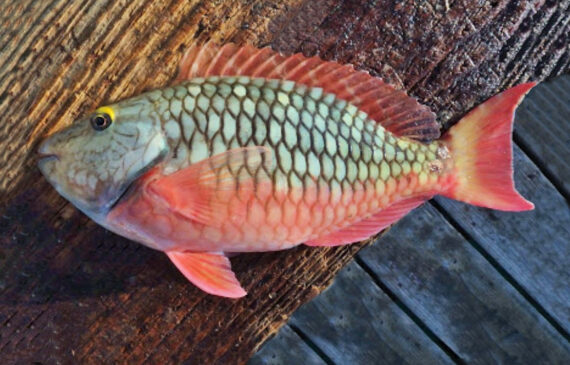 Stoplight Parrotfish, Sparisoma aurofrenatum, Initial Phase (IP) Female. Fish caught from coastal waters off San Juan, Puerto Rico, December 2013. Length: 13 cm (5.1 inches). Catch, photograph, and identification courtesy of Josh Leisen (joshadventures.com), Gaylord, Michigan.
Stoplight Parrotfish, Sparisoma aurofrenatum, Initial Phase (IP) Female. Fish caught from coastal waters off San Juan, Puerto Rico, December 2013. Length: 13 cm (5.1 inches). Catch, photograph, and identification courtesy of Josh Leisen (joshadventures.com), Gaylord, Michigan.
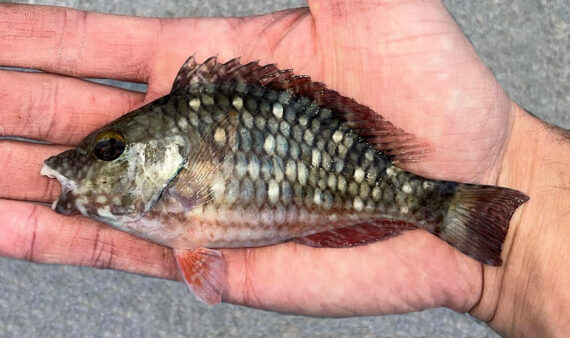 Stoplight Parrotfish, Sparisoma aurofrenatum, Initial Phase (IP), Female. Fish caught from coastal waters off Miami, Florida, January 2022. Length: 15 cm (6.9 inches). Catch, photograph and identification courtesy of James Lafontaine, Long Island, New York.
Stoplight Parrotfish, Sparisoma aurofrenatum, Initial Phase (IP), Female. Fish caught from coastal waters off Miami, Florida, January 2022. Length: 15 cm (6.9 inches). Catch, photograph and identification courtesy of James Lafontaine, Long Island, New York.
 Stoplight Parrotfish, Sparisoma aurofrenatum, Initial Phase (IP) Female. Fish caught off the Channel 5 Bridge (MM 71.4), Florida Keys, Florida, December 2015. Length: 25.5 cm (10 inches). Catch, photograph and identification courtesy of George Brinkman, Guelph, Ontario, Canada.
Stoplight Parrotfish, Sparisoma aurofrenatum, Initial Phase (IP) Female. Fish caught off the Channel 5 Bridge (MM 71.4), Florida Keys, Florida, December 2015. Length: 25.5 cm (10 inches). Catch, photograph and identification courtesy of George Brinkman, Guelph, Ontario, Canada.
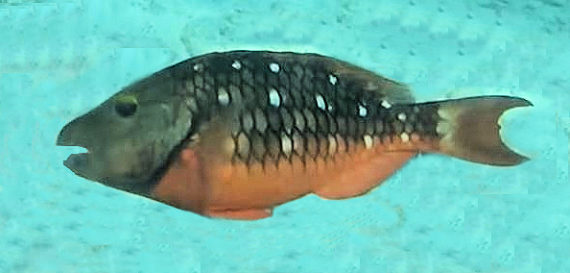 Stoplight Parrotfish, Sparisoma aurofrenatum, Initial Phase (IP) Female. Underwater photograph taken in coastal waters off Yal-Ku, Quintana Roo, April 2016. Photograph courtesy of Juan Rojo, Akumal.
Stoplight Parrotfish, Sparisoma aurofrenatum, Initial Phase (IP) Female. Underwater photograph taken in coastal waters off Yal-Ku, Quintana Roo, April 2016. Photograph courtesy of Juan Rojo, Akumal.
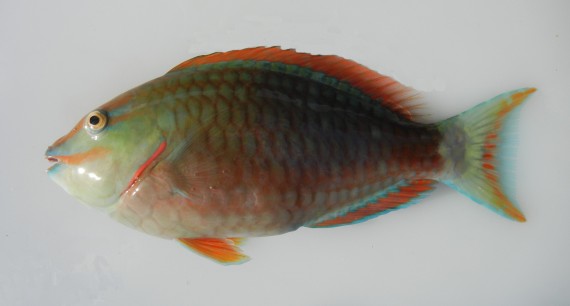 Stoplight Parrotfish, Sparisoma viride, Initial Phase (IP) Female Transitioning To Terminal Phase (TP) Male. Fish caught from coastal waters off Key West, Florida, August 2014. Length: 28 cm (11 inches). Catch, photograph and identification courtesy of Dean Kimberly, Atlanta, Georgia.
Stoplight Parrotfish, Sparisoma viride, Initial Phase (IP) Female Transitioning To Terminal Phase (TP) Male. Fish caught from coastal waters off Key West, Florida, August 2014. Length: 28 cm (11 inches). Catch, photograph and identification courtesy of Dean Kimberly, Atlanta, Georgia.
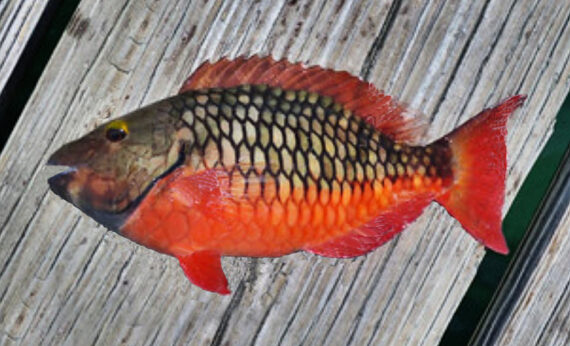 Stoplight Parrotfish, Sparisoma aurofrenatum, Initial Phase (IP) Female. Fish caught from coastal waters off Fort Lauderdale, Florida, December 2016. Length: 33 cm (13 inches). Catch, photograph and identification courtesy of Eli (obsessiveangling.wordpress.com).
Stoplight Parrotfish, Sparisoma aurofrenatum, Initial Phase (IP) Female. Fish caught from coastal waters off Fort Lauderdale, Florida, December 2016. Length: 33 cm (13 inches). Catch, photograph and identification courtesy of Eli (obsessiveangling.wordpress.com).
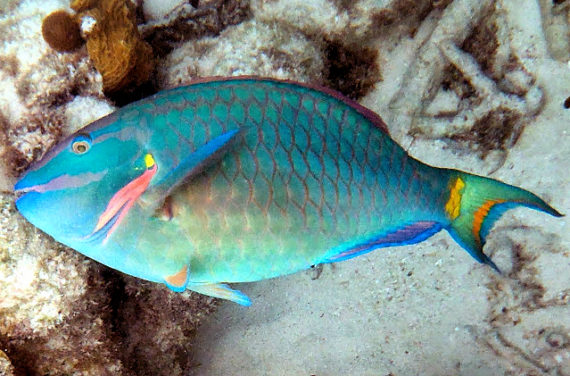 Stoplight Parrotfish, Sparisoma viride, Terminal Phase (TP) Male. Underwater photograph taken in coastal waters off Yal-Ku, Quintana Roo, March 2017. Photograph courtesy of Chery Anne Orrell, Montrose, British Columbia, Canada.
Stoplight Parrotfish, Sparisoma viride, Terminal Phase (TP) Male. Underwater photograph taken in coastal waters off Yal-Ku, Quintana Roo, March 2017. Photograph courtesy of Chery Anne Orrell, Montrose, British Columbia, Canada.

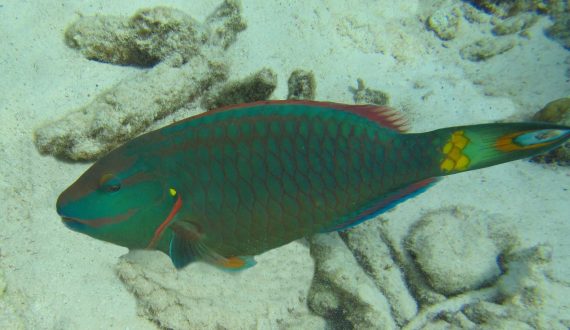 Stoplight Parrotfish, Sparisoma viride, Terminal Phase (TP) Male. Underwater photographs taken in coastal waters off Bonaire, December 2019. Photographs courtesy of Bob Hillis, Ivins, Utah.
Stoplight Parrotfish, Sparisoma viride, Terminal Phase (TP) Male. Underwater photographs taken in coastal waters off Bonaire, December 2019. Photographs courtesy of Bob Hillis, Ivins, Utah.
The Stoplight Parrotfish, Sparisoma viride, is a member of the Parrotfish or Scaridae Family, and are known in Mexico as loro brilloso. They get their common name from a yellow spot near the pectoral fin which is found only in terminal phase (TP) males. Globally, there are fifteen species in the genus Sparisoma, of which six are found in Mexican waters, all in the Atlantic Ocean.
The Stoplight Parrotfish is a large fish with oblong elongated moderately-compressed robust body. Their head is bluntly rounded. They vary greatly in color depending on their phase. Juveniles have a dark red-brown body with three rows of white spots running the length of the body; their bellies are paler in color and their truncated caudal fin features a white bar. In the Initial Phase (IP) both females and males are mottled red-brown, often mixed with white scales on the upper two-thirds of the body, and are bright red ventrally. They have horizontal rows of 5 pale spots on their sides; their anal and pectoral fins are bright red; their caudal fin is white transitioning to red-brown; and their dorsal fin is reddish-brown. Males in the terminal phase (TP) are green with diagonal orange bands on the upper half of their head. Their caudal fin has an orange crescent or lunate shaped indentation. They have yellow spots near the top of their gill cover and another at the base of their caudal fin. They have traditional parrot-like teeth used for crushing skeletal coral materials. Their anal fin has 3 spines and 9 rays; their caudal fin is lunate; and, their dorsal fin has 9 spines and 10 rays. They have 17 to 21 gill rakers. Their body is covered with large scales.
The Stoplight Parrotfish is found in coral reef environments at depths up to 50 m (165 feet). They favor Branched Finger Coral, Porites porites, which provides shelter, protection, and a food source. Juveniles are found in seagrass beds. They reach a maximum of 61 cm (2 feet 0 inches) in length and 1.6 kg (3.5 lbs) in weight; they are common at lengths of 30 cm (12 inches) to 46 cm (18 inches). Fish that are longer than 18.0 cm (7.0 inches) are normally TP males. As of January 1, 2024, the International Game Fish Association world record stood at 0.91 kg (2 lbs 0 oz) with the fish caught in coastal waters off Fort Lauderdale, Florida in April 2015. Population densities are greater offshore than inshore which is attributed to fishing pressures. They are diurnal and forage on benthic algae, corals, and seagrass. They are important bioeroders with each individual being capable of returning as much as 1 ton of sand to the environment per year. IP individuals can be either males or females, however, they are primarily males. Females eventually transition to males at mid-life and when population numbers are low. They are hermaphrodites and live in harems with a dominant male. Eggs are released in shallow waters and the juveniles move to shallow reef environments. They live as solitary individuals or in small groups and are known to exhibit aggressive behavior. They sleep at night within rock structure on the bottom. They are preyed upon by jacks, moray eels, and snappers. The Stoplight Parrotfish is poorly studied with very limited information available about their lifestyle and behavioral patterns including specific details on age, growth, longevity, movement patterns, diet, habitat use, and reproduction.
The Stoplight Parrotfish is a resident of Mexican waters of the Atlantic Ocean including the Gulf of Mexico and the Caribbean.
The Spotlight Parrotfish cannot easily be confused with any other species due to its unique coloration.
From a conservation perspective the Stoplight Parrotfish is currently considered to be of Least Concern with stable, widely distributed populations. They are not considered an important food fish as they are known to contain ciguatoxin. They are a favorite of divers allowing a close approach and then a hasty and spectacular departure. They are also a highly prized species for public aquariums.